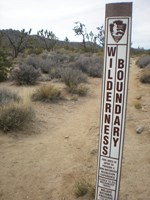|
What is the difference between designated Mojave Wilderness and other undeveloped areas in Mojave National Preserve? Wilderness areas generally do not allow motorized equipment, motor vehicles, mechanical transport (i.e. bicycles), temporary roads, permanent structures or installations. Wilderness areas are to be primarily affected by the forces of nature, though the Wilderness Act does acknowledge the need to provide for human health and safety, protect private property, control insect infestations, and fight fires within the area. Isn't wilderness just a "lock-up" of public land that locks people out? More than 12 million people visit wilderness areas each year, where they may hike, fish, camp, watch wildlife, photograph, or hunt (where legally authorized). Park visitors who do not enter into a wilderness area, might nevertheless enjoy wilderness as a scenic backdrop to developed park areas. What should I do differently in Mojave Wilderness? In Mojave Wilderness, you'll have an exceptional opportunity to experience the intellectual, inspirational, and recreational values of a truly wild land. Wilderness areas are places where humility and respect play a role in both individual and management activities. Can I drive in Mojave Wilderness? 
NPS/Michael Glore How do I recognize wilderness boundaries? How will I know if I’m in Mojave Wilderness or some other backcountry area? Wilderness boundaries are also marked by means of flexible, brown wilderness marking posts. Motorists, especially, should be aware of such boundaries when traveling in Mojave National Preserve. Roads open for travel by motor vehicles are indicated on current Trails Illustrated maps and in the official Mojave National Preserve brochure or "uni-grid" (both available at information centers). |
Last updated: February 14, 2025
